
By Jay Sahadew, marketing manager, Arconic
For years, welding was seen as the only way to ensure the integrity of joints in demanding load-bearing or high-vibration structures. So, companies manufacturing heavy-duty equipment or fabricating large, metal structures continued to employ the universally accepted process of welding joints together.
However, today there are alternatives to welding, one of the foremost being direct-tension installed, swaged lockbolts, such as the HuckBolts® currently offered by Arconic Fastening Systems and Rings. These unique engineered fasteners, proven in such demanding applications as truck suspensions and chassis, railroad track crossings, and heavy defense vehicles, are now being used in a number of products and structures where welding was once the only option.
Welding – proven, but not without drawbacks
While welding is proven to be one of the surest processes for securing a joint, there are a number of issues relating to it. To begin, the welding process is very time consuming, particularly in situations where in-depth inspection procedures are required. Welding also requires skilled, often highly paid, technicians. And in some industries, such as oil and gas, quality welders are both difficult to find and to retain.
The heat generated by welding can often reduce the strength of the metals being joined, and damage critical surface coatings. In addition, welding dissimilar metals or pieces of varying sizes can be a challenge. Welding also often requires an on-going process of inspection, with many of these procedures being both costly and time consuming. And as most companies who make extensive use of welding as part of their manufacturing or fabrication process have discovered, the removal and/or rework of a weld can be problematic.
Last, but most assuredly not least, welding is a dirty, dangerous process. Safety is a critical issue, since many fires have been started by a random spark created while welding. At the same time, spent rods and other remnants of the welding process are an ongoing housekeeping issue in shops where welding is performed on a regular basis.
Engineered lockbolts – an alternative to welding
Over the past 30 years, engineered lockbolts – such as Arconic Fastening Systems and Rings' HuckBolts – have replaced welding in more and more heavy demanding applications. Today, one can find advanced HuckBolt fasteners doing the job in a wide range of applications that once solely belonged to welding.
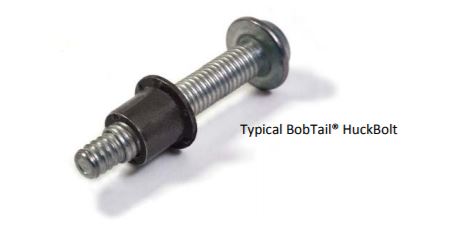
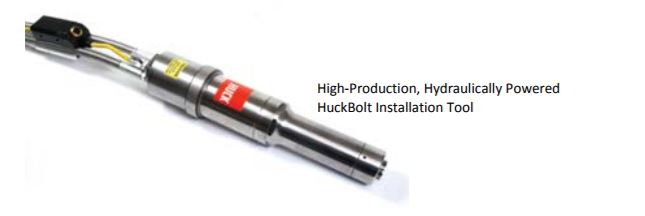
Structural HuckBolts, offered in a wide range of sizes (up to 1 3/8 inch) and materials, consist of a pin and a collar. These advanced fasteners are installed using a direct tension technique, in which the pin is pulled and the collar is simultaneously swaged into the locking grooves of the pin, deforming the collar into the grooves. Based on their design and unique direct tension installation, HuckBolts deliver ultimately consistent clamp for a strong, stable, and vibration-resistant joint.
There are a number of reasons why many manufacturers of heavy equipment are actively investigating the possibility of using direct-tension lockbolts in their assembly process.
To begin, even taking into consideration the need to drill a hole, installing a lockbolt is significantly faster than welding a joint. And a quick visual inspection is all that is required to confirm the accuracy and quality of the installation. In addition, an operator requires a minimal amount of training in order to be proficient in the installation of HuckBolts. One is no longer at the mercy of a limited pool of expensive skilled labour.
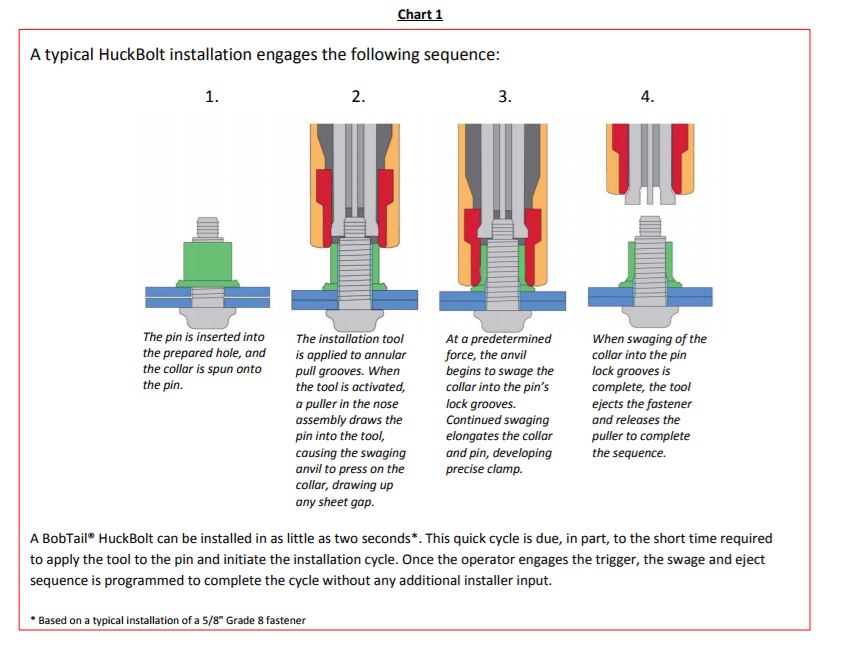 HuckBolts can be effectively used with virtually any metal, and dissimilar metals with dissimilar coefficients of thermal expansion present no problems. Varying piece sizes in a joint are readily accommodated, and surface finishes are not harmed. And most importantly, HuckBolts are proven to hold up over years of service in demanding high-stress, high-vibration environments.
HuckBolts can be effectively used with virtually any metal, and dissimilar metals with dissimilar coefficients of thermal expansion present no problems. Varying piece sizes in a joint are readily accommodated, and surface finishes are not harmed. And most importantly, HuckBolts are proven to hold up over years of service in demanding high-stress, high-vibration environments.
Finally, employing lockbolts, such as the HuckBolt, in key joining applications eliminates all of the housekeeping and safety issues that are integral to the welding process. HuckBolts are installed using a quiet, jolt-free swaging action, eliminating the potential for repetitive stress syndrome issues. There are no sparks to start fires or cause explosions, nor any debris on the floor that can lead to slips and falls.
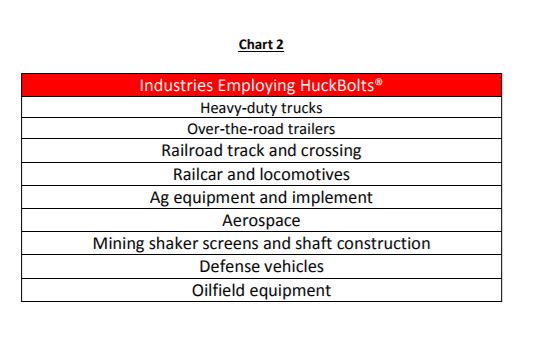
HuckBolt® fastening technology – eliminating the effects of vibration
In addition to providing for faster, safer, and more accurate joining of pieces, there are several unique design elements of HuckBolts that also ensure their ultimate resistance to the effects of vibration. Compared to conventional nut and bolt installations, which can loosen in high-vibration environments, HuckBolts have proven to be impervious to the effect of vibration in a number of very demanding applications. The secret to this performance difference can be found in the unique HuckBolt design, in which the collar is fully swaged into the locking grooves of the pin (Chart 3).
In contrast, conventional nut and bolt fasteners leave a slight gap between the crest and root of the threads when installed. This gap becomes problematic when exposed to transverse vibration, and can allow for rapid loss of clamp.
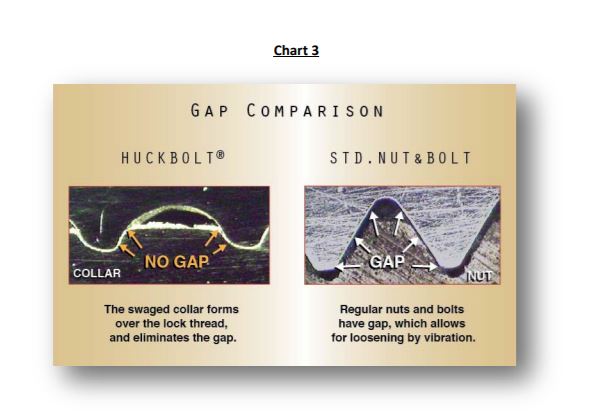
Another key difference between HuckBolt and conventional fastener installations is found in the structure of the threads of each of the fastening systems. Instead of the deep threads required to achieve a tolerance fit between conventional nuts and bolts, the HuckBolt pin requires only shallow locking grooves into which the collar is swaged. The shallow design of the locking grooves allows for a much larger pin root radius, which contributes significantly to the fatigue strength – up to 5 times that of a conventional nut and bolt. Overall, a HuckBolt lockbolt provides superior vibration resistance, as indicated by the study charted below (Chart 4).
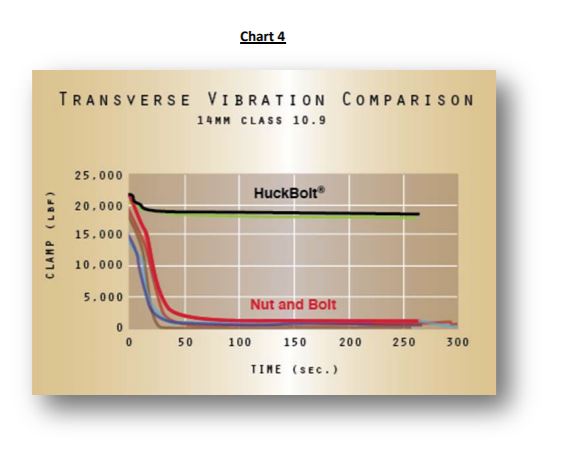
Huck structural blind rivets
For applications where only one side of the joint material is accessible, performance engineered Huck structural blind fasteners can often meet design requirements. These blind fasteners can deliver the shear and tensile strength to meet the demands of a number of heavy-duty applications. Available in diameters ranging from 3/16 inch to ¾ inch, these fasteners offer a combination of strength and vibration resistance, easy installation, and a high level of safe operation.
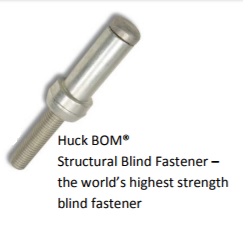
Summary
It should be noted that HuckBolts and Huck structural blind fasteners are not designed to replace all welds. These fasteners can leave a protrusion, which may not be acceptable for some applications. However, there are many applications, where welding has been traditionally employed, in which these fasteners are a viable alternative. Engineered for easy installation, and long, reliable life, these direct tension HuckBolts and structural blind fasteners can be a faster, more cost efficient, and safer alternative to traditional welding processes.
For more information on the full line of HuckBolt direct tension-installed fasteners, please visit www.AFSHuck.net/NoWeld

Will joined Fastener + Fixing Magazine in 2007 and over the last 12 years has experienced every facet of the fastener sector – interviewing key figures within the industry and visiting leading companies and exhibitions around the globe. Will manages the content strategy across all platforms and is the guardian for the high editorial standards that the brand is renowned.





